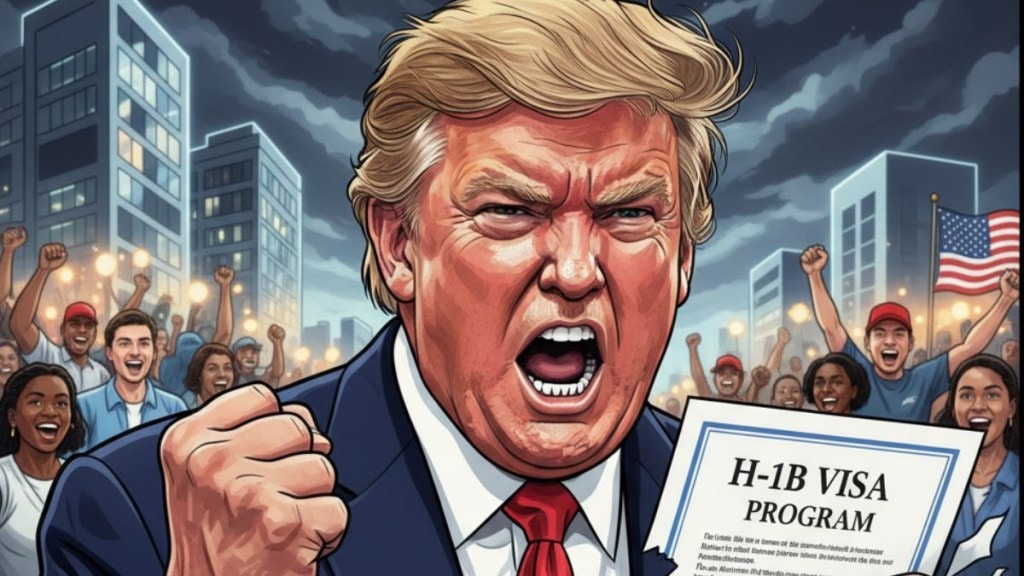For years, the American dream has been a big goal for techies, with landing a job at top companies in Silicon Valley seen as the ultimate career achievement.
When the H-1B visa was introduced as part of the Immigration Act of 1990, its purpose was clear, to help US employers fill skill gaps by bringing in qualified foreign workers when American talent was in short supply.
Now, Trump has signed an executive order that would require an employer to sign a $100,000 annual fee for H-1B visas to reduce “overuse of the program”.
America loved this program initially, but when and why did they start disliking it? Let’s break it down:
H-1B visa holders turned out to be job stealers
In August 2025, the US job market hit a rough patch. Job growth slowed dramatically, with only 22,000 new jobs added, a sharp drop compared to previous years.
The unemployment rate also climbed to 4.3%, the highest it had been in nearly four years. As the economy struggled, many Americans started to point fingers at foreign workers on H-1B visas, blaming them for taking jobs that could go to US citizens.
This is also reflected in Lutnick’s statement, Commerce Secretary Howard Lutnick said, “So no longer will you put trainees on an H-1B visa. That it’s just not economic anymore. If you’re going to train people, you’re going to train Americans… If you have a very sophisticated engineer and you want to bring them in… then you can pay $100,000 a year for your H-1B visa,” which indicates America only wants outsiders if they are an expert.
On social media, many Americans are angry, feeling like H-1B workers are taking away opportunities in an already tight job market.
Layoffs and less hiring
By August 2025, US companies had announced nearly 86,000 job cuts, a 39% jump from July and the highest number of layoffs in August since 2020.
So far this year, layoffs have been averaging about 1.8 million per month. Hiring in August was barely better, with only a 1% increase compared to July, and about 4% lower than the same time last year.
Job openings also dropped to 7.18 million in July, the lowest in almost a year, and below what experts had expected.
The biggest drops in job openings were in fields like healthcare, social services, and entertainment. Overall, hiring is still more than 20% lower than it was before the pandemic in 2019.
With so many people losing their jobs and fewer new opportunities out there, it’s no surprise that many Americans feel frustrated seeing foreign workers taking jobs in the US right now
Anti-India sentiment and Culture
The real backbone of the H-1B visa program is Indians, with around 71% of FY2024 approved petitions going to India-born applicants. Of these, approximately 64% were for IT-related roles.
Recently, there has been a rise in anti-Indian sentiments in the US, with many blaming the H-1B visa program for taking jobs away from Americans.
According to the AAPI Equity Alliance’s “Stop AAPI Hate” report, over 75% of anti-Asian hate speech between December 2024 and January 2025 was aimed at South Asians.
In fact, a group called Moonshot, which tracks online hate, found that more than 44,000 racist slurs against South Asians appeared in extremist online spaces between May and June of 2025.
Even public figures like Vice President Kamala Harris and Usha Vance, both of Indian descent, have not been spared from this wave of hate.
A study called ‘Anti-Indian Racism on X’ by the Center for the Study of Organized Hate,’ found that between July 1 and September 7, 2025, nearly 700 hateful posts against Indians on the social media platform X received over 281 million views.
These posts often painted Indians as “invaders” or “job stealers” and called for their deportation.
In fact, about 70% of these posts were focused on immigration issues, making anti-Indian rhetoric linked to jobs and deportation the main driver of this online hate.
Russian oil and Trump tariffs
On top of the growing anti-Indian sentiment, President Trump’s actions have added fuel to the fire. He imposed a 50% tariff on goods imported from India because the country continued to buy oil from Russia.
Trump argued that this would only make Russia’s war in Ukraine worse. While he has recently tried to ease tensions by saying he has a “very good relationship” with India’s prime minister, these diplomatic issues have only increased the negative feelings towards Indians, especially H-1B workers.
With the new changes to the H-1B visa program, it is clear that America will only be looking for highly skilled workers.
So, for anyone dreaming of making it in the US, the path to the American dream is going to be much harder than it was before.

